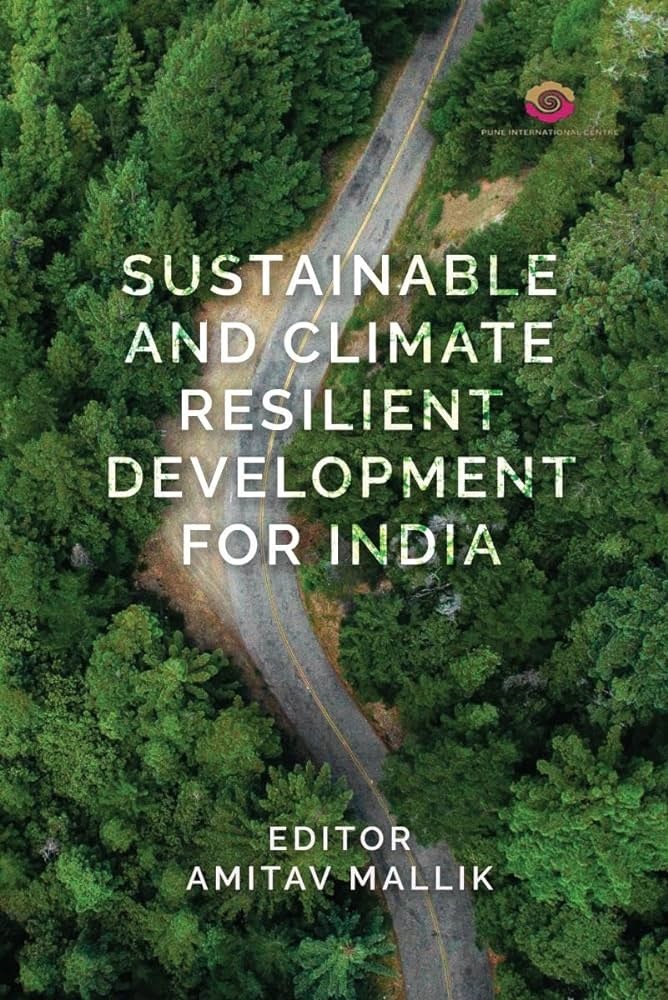Book Summary by Pradeep Nair, Sr. Editor, PIC
The book begins with an illustration of a dystopian world. A father and son are sitting on stacks of currency notes and warming over a fire in the midst of a barren landscape with stubs of felled trees, more stacks of money littered about, and the faint silhouette of a city’s ruins at a distance. The father remarks, “At least we made a lot of money before destroying the environment,” to which the boy asks, “What’s for dinner, dad?”
The illustration, while depicting a world that prioritises monetary gains at the expense of the environment, also points to what the book offers: an exploration of the complex relationship between humans and their environment, energy, and economy.
Edited by Prof. Amitav Mallik, eminent laser scientist, a trustee of PIC, and head of its Energy, Environment, and Climate Change (EECC) research vertical, the volume features contributions from nine experts. Across 11 chapters, they explore—as PIC Vice President Dr. Vijay Kelkar notes in the Foreword—‘desirable pathways to Sustainable Development in a Climate-Challenged world’.
In the opening chapter, Prof. Mallik challenges the idea that economic progress must come at the expense of environmental stewardship. Instead, he advocates ‘climate-resilient human development’ that puts human well-being at its centre and is not tied to GDP alone. Citing data on top carbon emitters globally, he draws attention to the gravity of the climate change threat, its potential to lead to ‘extinction of all life’, and the impact on health, nutrition, education, jobs, and livelihoods. The chapter examines the outcomes of climate treaties, unique challenges faced by India, and the way forward.
Subsequent chapters go deeper into specific aspects of the human-development-energy-economy dynamics.
Dr. Gurudas Nulkar brings up the ‘other part’ of the ‘green growth’ idea—‘decoupling economic growth from natural resource consumption and environmental degradation’. Citing data, he suggests ways to achieve climate-resilient growth, especially through new policies.
Dr. Ejaz Ghani connects India’s economic growth story with its vulnerability to climate change, underscoring the need for structural reforms to achieve balance between economic growth and climate action. He explores the challenges and solutions for India in areas of industrialisation, resource management, climate finance, and innovation promotion, while staying on a climate-friendly growth path.
Giving an overview of the carbon-intensive consumption patterns of countries such as China and the US and the progress made by them to achieve net zero, Ajay Shankar says India, being in its early stages of development, should learn from their experiences. He explores the opportunities and challenges for India in transitioning to renewables, especially for electricity generation.
Dr. Nitin Mate underscores the role of technology in achieving a net-zero economy. He makes a case for using technology to harness the sun as it is the ‘only non-polluting and sustainable source of energy’, and avoiding finite energy resources, even nuclear, which creates hazardous waste. With easy flow charts and tables on available renewable energy resources, he explains their comparative generation potential, cost, and the technological details of their application. He calls for using local resources, and introducing ‘decentralised smart microgrids of renewable energy hybrids’ to help India become carbon neutral by 2050.
Aditi Kale underscores the need to prioritise protection and restoration of India’s natural ecosystems to ensure quality of life, resilience to natural disasters, and sustained livelihoods. She concludes with a warning: the window for meaningful climate action may be shrinking too fast.
Building governance and institutional capacity for India to achieve net zero by 2070 is the focus of Megha Phadkay’s chapter. She explores the curious connection between climate and India’s elections, such as voter turnout during harsh summers, emphasising the need to make the electoral process climate-resilient. She explores the impact of GDP-obsessed growth, agricultural practices, leadership, and civil society behaviour on sustainability, and lists key areas to act.
Shalvi Pawar examines essential approaches to sustainability, such as ‘greening the gap’ in the understanding of sustainability. The chapter examines the psychology behind climate ‘inaction’, and the importance of goal-setting, NDCs (Nationally Determined Contributions), and policies in combatting climate change.
Dr. Priyadarshini Karve explains how ethical principles have been sidelined as patterns of consumption and movement of goods changed from pre-Industrial Revolution times when renewables like human and animal labour and water and wind flows were used for transport. With graphs, she gives an overview of emissions over time and concludes by suggesting pathways to an ethical approach to climate action, especially through concepts like ‘carbon budget’.
In another chapter, Dr. Ejaz Ghani looks at ways to maximise climate finance in India, especially by tapping into the private sector, and through financial instruments like ‘green bonds’ and ‘green funds’.
Prof. Mallik’s concluding chapter reflects on the evolving Earth environment and humanity’s future, and raises the question: ‘Are we doing enough?’. He urges a cooperative approach among governments, industry and individuals; creating ‘green jobs’; and finding local solutions, while also being inclusive.
The well-researched book transcends mere academic discourse to offer actionable solutions and a roadmap towards a sustainable future, making it a valuable resource for scholars, policymakers and lay readers alike.

